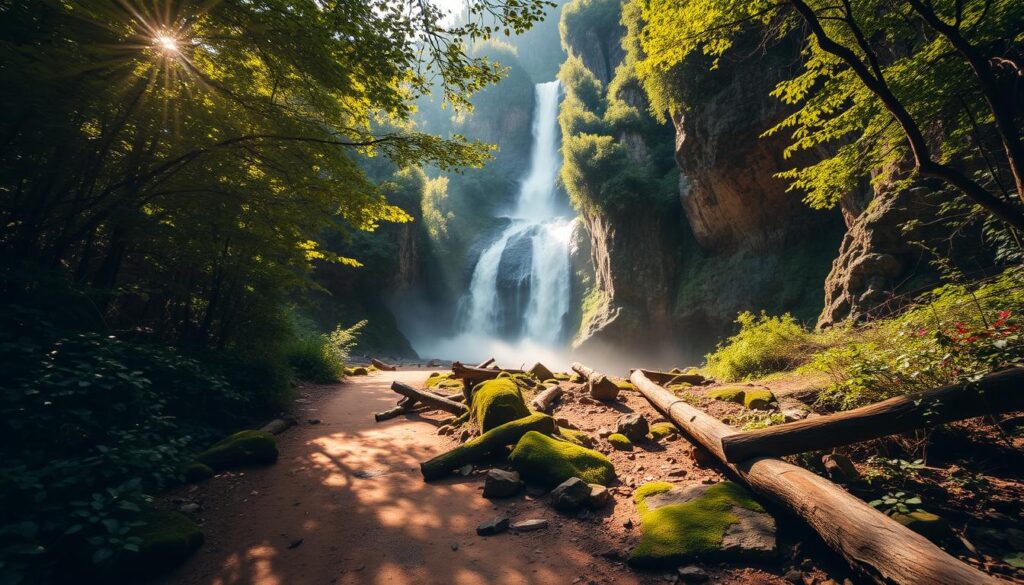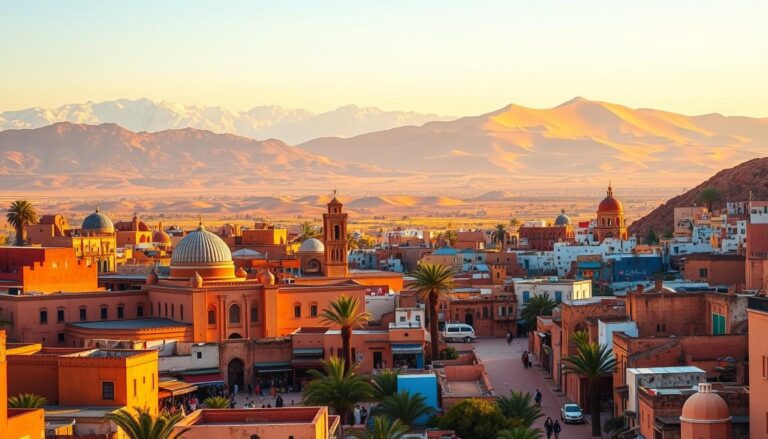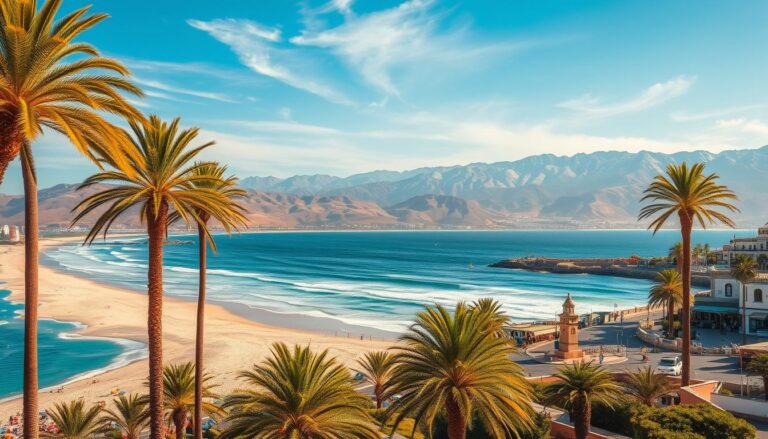Ouzoud Falls in Morocco: A Natural Wonder
Table of Contents
Did you know that North Africa’s tallest waterfall cascades over 110 metres through a landscape dotted with ancient olive trees? This breathtaking spectacle, located just 150 kilometres northeast of Marrakech, draws thousands of visitors yearly—and for good reason.
Steeped in Berber legends, the falls offer more than raw natural beauty. The roar of water plunging into emerald pools blends with the chatter of wild macaques, creating an atmosphere that feels both wild and welcoming. Rugged cliffs frame the scene, while mist-kissed rainbows often dance in the sunlight.
What truly sets this place apart is its rare mix of adventure and heritage. You can hike winding trails, paddle traditional boats at the base, or explore nearby mills that whisper tales of centuries past. It’s a destination where every turn reveals something new—whether you’re a thrill-seeker or a culture enthusiast.
Key Takeaways
- North Africa’s highest waterfall at 110 metres, surrounded by olive groves
- Easily accessible from Marrakech, making it ideal for day trips
- Rich in Berber history and local folklore
- Opportunities for hiking, swimming, and wildlife spotting
- Vibrant rainbows frequently visible in the spray
Planning Your Day Trip to Ouzoud Falls
Timing and preparation can make or break your adventure to North Africa’s cascading marvel. Most travellers begin their journey from Marrakech, where organised tours depart around 7–8 am for the 3–4 hour drive. While the route winds through scenic valleys, packing smartly and choosing your hours wisely ensures you’ll maximise every moment.
Choosing the Best Time for Your Visit
Spring (March–May) and autumn (September–November) offer mild temperatures and vibrant greenery. Arrive before 10 am to beat coach tours and capture the falls’ rainbows in soft morning light. Weekdays see fewer visitors than weekends – a crucial tip if you prefer quieter trails.
Essential Gear and What to Pack
Sturdy walking shoes are non-negotiable for navigating rocky paths. Toss in a lightweight waterproof jacket, sunscreen, and a refillable water bottle. Guides often recommend carrying small notes (dirhams) for boat rides, snacks from local vendors, or unexpected stops along the way.
Joining a day tour simplifies logistics with included transport and knowledgeable commentary. For flexibility, book a private taxi and add 30 minutes to your schedule for impromptu photo stops. Either way, those extra minutes spent chatting with drivers often reveal hidden viewpoints or seasonal wildflower displays you’d otherwise miss.
Understanding the Natural Beauty of Ouzoud Falls
Few places weave history and scenery as seamlessly as this cascade, where every splash tells a story. Its name, rooted in the Berber word for “olive”, reflects the silvery-green groves that blanket the valleys below. These ancient trees have watched over the falls for centuries, their gnarled branches framing views of water tumbling over rust-coloured cliffs.
The History and Legend Behind the Waterfalls
Local tales speak of spirits guarding the plunge pools, their whispers carried on the mist. One legend claims the falls formed when a heartbroken giant wept into the river—a poetic origin for its three thunderous tiers. The rhythmic roar creates a natural soundtrack, shifting from gentle murmurs to booming crescendos as you descend the trails.
Highlights of the Olive Tree-Dotted Landscape
Over 2,000 olive trees thrive here, their roots gripping the rocky slopes. Farmers still harvest the fruit using traditional methods, pressing oil in mills powered by the falls’ streams. This symbiotic relationship between water and agriculture shapes both the scenery and local livelihoods.
| Natural Feature | Description | Best Viewing Spot |
|---|---|---|
| Cascading Tiers | Three distinct drops creating mist-filled canyons | Midway viewpoint on main trail |
| Olive Groves | Century-old trees producing prized local oil | Valley floor near boat launch |
| Rainbow Mists | Sunlight refracting through midday spray | Base of second waterfall tier |
Walking through this landscape feels like stepping into a living postcard. Crystal-clear pools mirror the sky, while dragonflies dart between wildflowers clinging to crevices. It’s a place where nature’s raw power meets delicate beauty—a contrast that leaves visitors awestruck.
Navigating morocco ouzoud falls: Routes and Transportation
Reaching this natural spectacle from Marrakech requires smart planning but rewards with unforgettable vistas. Whether you’re after convenience or flexibility, choosing the right transport services shapes your experience. Let’s map out your options.
Booking Tours and Taxi Options from Marrakech
Guided tours simplify your trip with door-to-door transfers and expert commentary. Reputable operators include stops at panoramic viewpoints and traditional villages, turning the 150-kilometre route into a cultural teaser. For those preferring independence, pre-booked taxis with air conditioning offer comfort – just confirm return times to avoid being stranded.
Scenic Routes and Key Waypoints on the Journey
The drive winds through the Atlas foothills, passing terraced fields and Berber hamlets. Allow three hours for the journey, as hairpin bends demand slower speeds. Local drivers often pause at Taddert’s argan oil cooperatives – perfect for stretching legs and sampling fresh almond pastries.
Self-drivers should download offline maps: mobile signals fade in mountain valleys. Whichever way you travel, morning departures beat traffic and deliver cooler hiking temperatures. Remember, reliable services book up fast in peak seasons – secure your spot at least two days ahead.
Experiencing the Adventure at the Base of the Falls
Descending to the foot of this natural marvel transforms sightseeing into an immersive journey. The rumble of crashing water grows louder with each step, pulling you towards the heart of the cascade. Prepare for mist-kissed skin, adrenaline-fuelled exploration, and moments that linger in memory long after you leave.

Hiking Down for Closer Views
The 30-minute hike to the bottom falls winds through shaded paths and stone staircases. Though manageable for most fitness levels, grippy soles prove essential on occasionally slippery rocks. As one visitor remarked, “You don’t conquer the trail – it guides you to something magical.”
Taking a Refreshing Raft Ride
Local boatmen offer wooden raft trips that bring you within arm’s reach of thundering cascades. These 10-minute journeys reveal hidden rock formations and create unforgettable photo opportunities. Expect playful splashes – and laughter – as you navigate the water’s powerful embrace.
| Activity | Duration | Highlights |
|---|---|---|
| Hiking | 25-40 minutes | 360° views, olive grove panoramas |
| Rafting | 8-12 minutes | Spray-filled perspectives, wildlife spotting |
Every extra minute spent at the bottom rewards with fresh discoveries. Sunlight filtering through mist creates ever-changing rainbows, while secluded pools invite quick dips. Whether you’re scrambling over boulders or floating peacefully, this experience redefines connection with nature.
Savouring Local Food and Refreshments
After working up an appetite exploring trails and waterfalls, you’ll find dining options that mirror the area’s rustic charm. Family-run eateries cluster near viewing platforms, serving hearty dishes amidst the buzz of fellow adventurers. While service can feel leisurely – one traveller joked, “The bread arrives faster than the cutlery!” – the flavours reward patience.
What to Expect at the Local Restaurants
Meals here focus on simplicity: think tagines simmered with homegrown vegetables or grilled meats paired with olive oil-drenched flatbreads. Portions lean modest, so consider ordering multiple starters if you’re peckish. Outdoor seating areas often double as monkey-watching spots, creating lively backdrops for your lunch.
Be prepared for cash-only transactions and menus translated into multiple languages. While waitstaff might seem stretched during peak hours, their warmth shines through – especially when recommending regional specialities like msemen (flaky pancakes) drizzled with local honey.
Tips for a Tasty, Budget-Friendly Lunch
To maximise value, opt for fixed-price menus offering starter, main and mint tea. Many restaurants near the base trails provide better deals than those at the top. Carry a reusable bottle to refill at spring water taps, saving both money and plastic waste.
Packing energy bars or nuts helps bridge gaps between meals without relying on pricey snack stalls. As one savvy visitor noted: “A picnic by the pools beats rushed service any day.” With some planning, you’ll enjoy authentic food experiences that fuel your adventures without draining your wallet.
Immersing Yourself in Local Culture and Wildlife
Beyond the cascading waters, a vibrant world of traditions and wildlife awaits your discovery. Local experts and curious creatures transform this natural wonder into a living classroom. Every interaction here deepens your connection to the landscape.

Engaging with Your Friendly Local Guide
Knowledgeable guides bring the area’s heritage to life through animated storytelling. You’ll hear about ancient milling techniques while examining weathered stone channels, or learn why certain plants thrive in the misty microclimate. “These trails aren’t just paths – they’re history books written in dust and olive leaves,” one guide shared during a recent tour.
Observing Barbary Macaques and Other Wildlife
Keep your camera ready for playful Barbary macaques swinging through argan trees. These charismatic primates often approach visitors, though feeding them is strictly discouraged. Birdwatchers might spot hoopoes flashing orange crests or hear the distinctive call of Levaillant’s woodpecker echoing through the gorge.
| Cultural Highlight | Wildlife Encounter | Best Time |
|---|---|---|
| Guided heritage walks | Macaque troop sightings | Early morning |
| Traditional tea ceremonies | Migratory bird activity | Spring/Autumn |
| Mill demonstrations | Butterfly migrations | Midday warmth |
Chatting with people who’ve lived here for generations often becomes a highlight for many tourists. Their insights turn ordinary viewpoints into portals to the past. As one traveller noted: “The guides didn’t just show us the falls – they helped us feel part of their story.”
Exploring Nearby Attractions and Hidden Gems
The magic of this region extends far beyond its famous cascade. While the thunderous waters captivate most visitors, quieter wonders await those willing to venture further. You’ll find serene springs, traditional settlements, and landscapes that reveal the area’s authentic character.
Visiting the Ouzoud Springs and Additional Natural Sites
A short route north leads to crystal-clear springs where water bubbles from limestone cliffs. These lesser-known sites offer peaceful swimming spots away from busier areas. Local shepherds often pause here with their flocks, creating picture-perfect moments of rural life.
Discovering the Local Villages and Markets
No experience here feels complete without visiting village Tanaghmeilt. Its earthen buildings blend seamlessly with the terrain, while weekly markets burst with handwoven rugs and aromatic spices. As one resident shared: “Our village remembers old ways – come taste life before smartphones.”
| Attraction Type | Highlights | Pro Tips |
|---|---|---|
| Natural Springs | Secluded pools, cool microclimate | Bring water shoes for rocky entries |
| Village Markets | Handcrafted pottery, fresh dates | Bargain politely – it’s part of the fun |
| Scenic Walks | Olive grove pathways, sunset views | Ask locals about hidden viewpoints |
In village Tanaghmeilt, follow narrow lanes to family-run workshops. Watch artisans shape tagine pots using methods unchanged for generations. For authentic souvenirs, seek out the blue-painted stall near the mosque – its owner crafts silver jewellery inspired by Berber symbols.
These off-the-beaten-track experiences transform a standard tourist trip into meaningful cultural exchange. Whether sipping mint tea in a village courtyard or tracing ancient footpaths, you’ll gain insights no guidebook can capture.
Conclusion
Your journey to North Africa’s towering cascade becomes more than a day out—it transforms into a sensory storybook. From the thunderous roar at the bottom of the falls to sunlit rainbows dancing in the spray, every moment etches itself into memory. Whether navigating winding trails or sharing mint tea with locals, you’ll collect experiences that linger long after your return.
To make the most of your day trip, start early to avoid crowds and pack sturdy shoes for exploring. Trust local guides to reveal hidden viewpoints and centuries-old olive groves. Those few hours spent hiking and rafting? They’ll feel like discovering a secret world just a couple of hours from Marrakech.
Ready to trade city bustle for nature’s symphony? This highlight of North Africa delivers adventure and calm in equal measure. When you go, capture those misty rainbows—and don’t forget to share your story. After all, some journeys aren’t just trips; they’re the “remember when…” tales you’ll recount for years.







